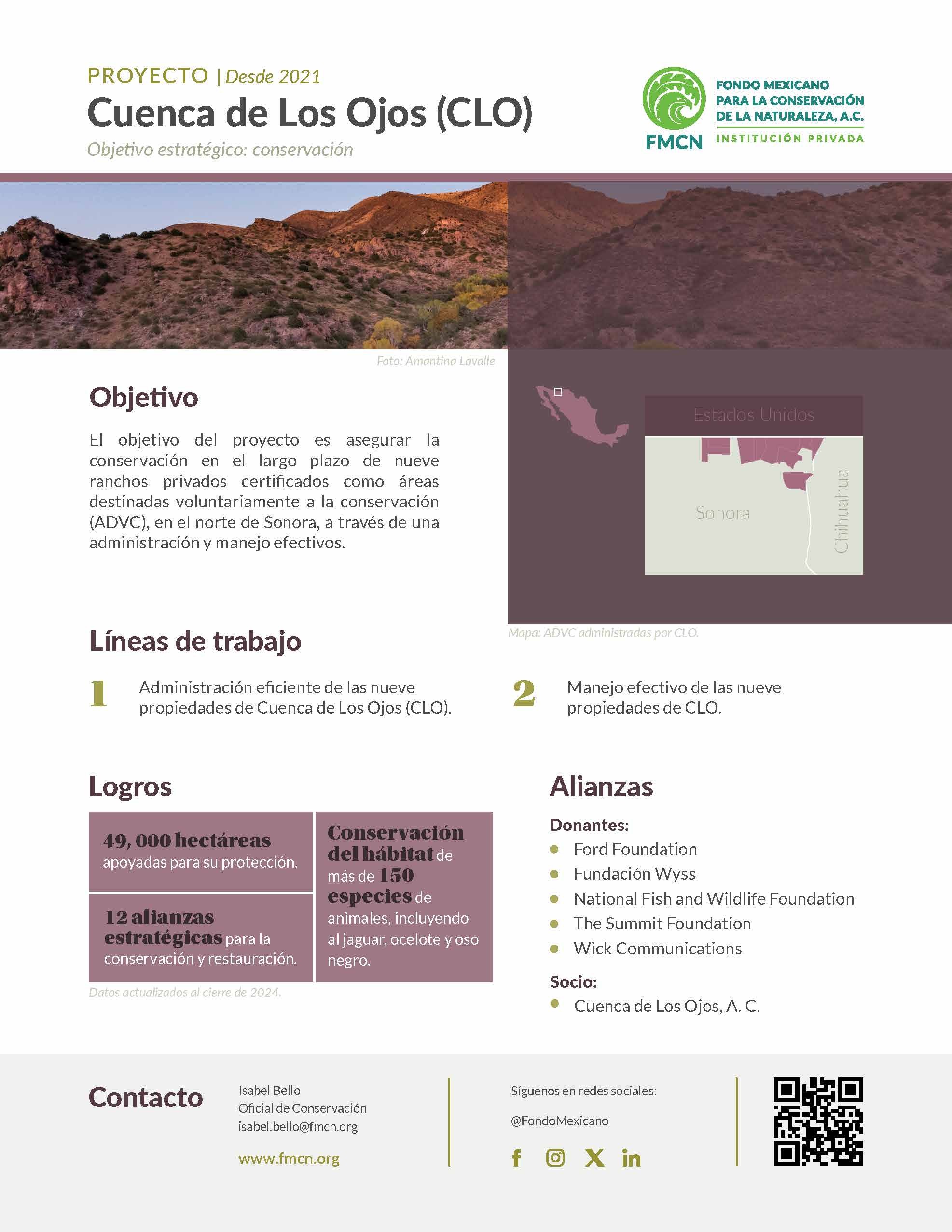Cuenca de Los Ojos
Managing the conservation of private ranches in northern Sonora
The Project
Cuenca de Los Ojos aims to ensure the long-term conservation of nine private ranches certified as Areas Voluntarily Designated for Conservation (ADVCs, acronym in Spanish) in northern Sonora, through effective management and administration.
Context
The region where it is located — the Sierra Madre Occidental in northeastern Sonora, bordering Arizona, United States — is recognized globally as a biodiversity hotspot. This area serves as a key binational biological corridor for many species of native and migratory wildlife, many of which are threatened or endangered.
The organization Cuenca de Los Ojos, A.C. (CLO) manages the ADVC of the same name, located in northeastern Sonora and made up of nine privately owned ranches. For over 30 years, CLO’s team has worked on the conservation and restoration of the ecosystems in the border region between Mexico and the United States, with the goal of protecting the region’s natural capital. This is where the Sky Islands, Sierra Madre Occidental, Chihuahuan Desert, and Sonoran Desert converge, creating a uniquely rich biodiversity of flora and fauna.
Since 2020, Mexican Fund for the Conservation of Nature (FMCN), CLO, and the Wyss Foundation have collaborated to ensure the long-term conservation of the ADVC. The Wyss Foundation provides endowment resources, whose returns are allocated annually to CLO for property management, while FMCN contributes matching funds for strategic conservation and management activities within the ADVC. CLO is responsible for the direct operation of the properties, with the objective of conserving their ecosystems and biodiversity.
The lines of work that guide the actions of CLO are:
- Efficient administration of the nine CLO properties.
- Effective administration of the nine CLO properties.
The project implemented by CLO aims to ensure the long-term conservation of nine ADVC-certified private ranches in northern Sonora.
Achievements
Nearly 50,000 hectares under protection, CLO continues its work in conserving grasslands and priority ecosystems, in coordination with various national and international organizations and universities. Species that benefit from these efforts include the American black bear (Ursus americanus), jaguar (Panthera onca), mountain lion (Puma concolor), ocelot (Leopardus pardalis), North American beaver (Castor canadensis), mule deer (Odocoileus hemionus), Yaqui catfish (Ictalurus pricei), golden eagle (Aquila chrysaetos), among other resident and migratory bird species.
In collaboration with the National Commission for the Knowledge and Use of Biodiversity (Conabio, acronym in Spanish), CLO uses the Permanent Calibration and Biodiversity Monitoring Sites (SiPeCaM, acronym in Spanish) tool to monitor key species. Thanks to this tool, the presence of black bears, deer, and mountain lions has been documented within the ADVC.
CLO also promotes environmental education by working with primary and secondary schools through educational talks and workshops focused on habitat and priority species conservation. Notably, it collaborates with the women’s collective Dougla-Prieta to organize herbal medicine workshops, strengthening ties with local communities and promoting the sustainable use of resources.
The CLO team remains committed to continuous learning. One highlight is their participation in the Regenerative Ranch Management course, the knowledge from which will be applied in the ADVC to help meet conservation goals.
In 2024, CLO developed a Waste Management Program that will first be implemented internally and later extended to the surrounding community. In addition, the organization achieved all six goals of its environmental education strategy, including workshops, ongoing staff training, and capacity-building for volunteers and interns.
CLO also maintains an active and well-equipped wildfire response brigade, which receives ongoing training. The team also performs regular maintenance on roads and infrastructure across the ranches.
By the end of 2024, CLO hosted two workshops to generate baseline information for the ADVC and continued implementing activities from its Environmental Education Program. These efforts strengthened synergies with schools, universities, and communities. Additional highlights include progress in outreach and communication, such as the development of birdwatching guides, operation of an agave nursery, and installation of interpretive signage across the properties.
Allies
Donors:
- Ford Foundation
- National Fish and Wildlife Foundation
- The Summit Foundation
- The Wyss Foundation
- Wick Communications
Partner:
